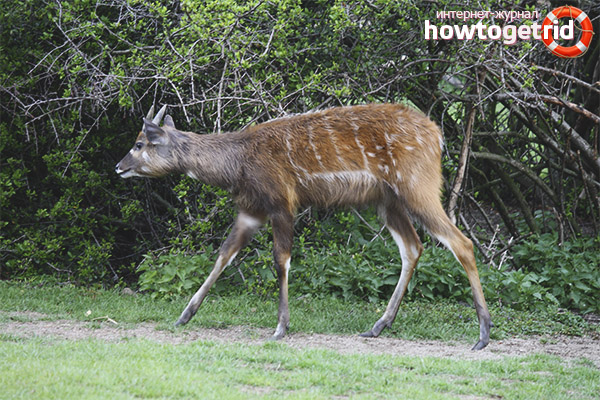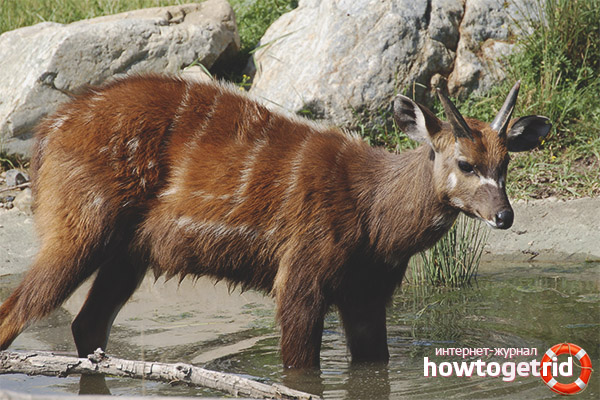The content of the article
The sitatung is a species of antelope classified as a forest type. The main distinguishing characteristic of these individuals is considered to be that they prefer to lead a semi-aquatic lifestyle. They feel great in fresh and salty springs, settle near lakes and rivers, and can live near swampy areas. To a greater extent, these animals are common in Africa. In today's article, we will study everything that affects this antelope, so that everyone can draw certain conclusions for themselves.
Description
- In height at the withers, the individuals represented can reach 80 cm or more. As for the length of the body, they extend up to 150 cm on average. The weight category fluctuates around 50-100 kg. In females, there are no horns. They are available in males, equipped with a pair of turns and reach a length of 80 cm.
- The wool is compacted, knocked down, thick, shaggy in some parts of the body, almost does not get wet due to the presence of water-repellent impregnation. By color, the coat is pigmented with reddish with reddish blotches. But individuals can be brown or brown-beige.
- Female animals and young animals that have not reached maturity are more pigmented than adult representatives of the species and males. When the animal grows and reaches puberty, it is painted in chocolate, brownish or gray tones. Also on the neck grows the so-called mane, consisting of core hair. The fur is longer along the ridge, it looks strange, to say the least.
- In the back there are marks of white tone. The same inclusions are observed on the muzzle, from the lateral parts of the body. However, they are poorly visible when the hair grows back. As for the hooves, they have a narrower and elongated format, extend up to 10 cm in length. There are false extensions, so the specimens are adapted to be found in swamps.
- The duration of gestation is 7 months. Kids can be born all year long. As a rule, the female gives only one cub, who initially lives in a secluded corner, and then begins to walk after her mother (after six months). Regarding puberty, animals reach it in a couple of years, some a year. Males have to wait up to 2.5 years. This antelope lives about 15 years.
- We have already mentioned that these individuals prefer to spend most of their life in the aquatic environment. They live among the reeds and near the swamps. Joint parts and hooves are adapted to movements in such territories. Animals do not get stuck in a swamp, they also swim very well, therefore in case of danger they prefer to hide in water. Individuals of this species dive almost completely, leaving only nostrils on the surface.
- Among the reeds, individuals make paths for themselves, along which they subsequently move. Hunters take advantage of this by setting traps in the path of antelopes. Animals are classified as nocturnal inhabitants, but they can stay awake at sunset or immediately after the sun comes out. The main thing is that in the habitat area there is a constant feed base.
- The voice of male representatives is similar to dog barking. By the nature of the stay, it cannot be said that individuals are loners. They can successfully exist in pairs, groups or small families.
Habitat
- These animals are classified as African. They are common, starting from the Sahara, ending with the northern borders of the country. However, the habitat is more chaotic than permanent. Animals are constantly changing the distribution area. They will always prefer swamps to other areas. Located near rivers and other water sources.
- It has already been said that these individuals are semi-aquatic. They swim perfectly, hide from enemies in the body of water, sticking out only their nostrils. It is also worth mentioning that antelopes can be under water, but a small amount of time.
- Find these representatives of the group will be next to cereal fields and reeds. They are located in papyrus and sedge thickets, the main thing is that the water level corresponds to the norm. Food includes sprouts.
Lifestyle
- Represented individuals try to stay awake at night. Such animals are semi-aquatic. If the antelope suddenly feels danger, it immediately dives into the water. Only nostrils can be observed on the surface. As a result, the animal leaves the pursuit without any problems.
- The considered animals perfectly adapted to the conditions of life in the swamp. Such antelopes have rather long and wide hooves. Therefore, they can perfectly move on muddy soil. Things are just opposite on solid ground, individuals look very awkward. For this reason, antelopes can not be found in the open.
- In most cases, the discussed individuals graze precisely in the reed and sedge thickets. Animals mainly feed on fruits, leaves, herbs and shoots of reeds. Most of their lives they spend in reed thickets. Due to the flexible joints and wide hooves, the antelopes are not buried in soft soil.
- In dense thickets, animals constantly trample their paths. It is on them that they further try to walk. Due to this characteristic feature, individuals often suffer from hunters. In such places, people place traps. Most often, antelopes are active at sunrise or sunset.
The Shitanungs are a rather unusual species of antelopes. They live in unusual terrain and are semi-aquatic animals. It remains interesting that the males of the species in question can bark loudly. Another characteristic feature is that they can live both individually and in groups. The main natural predators of antelopes are pythons, lions and leopards.











Submit